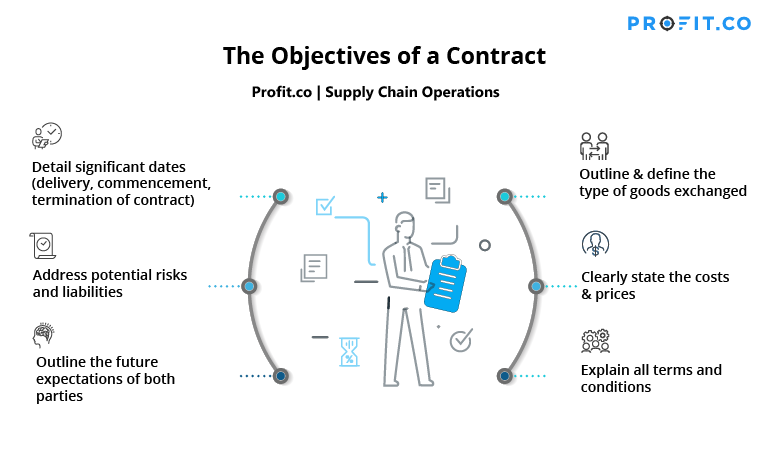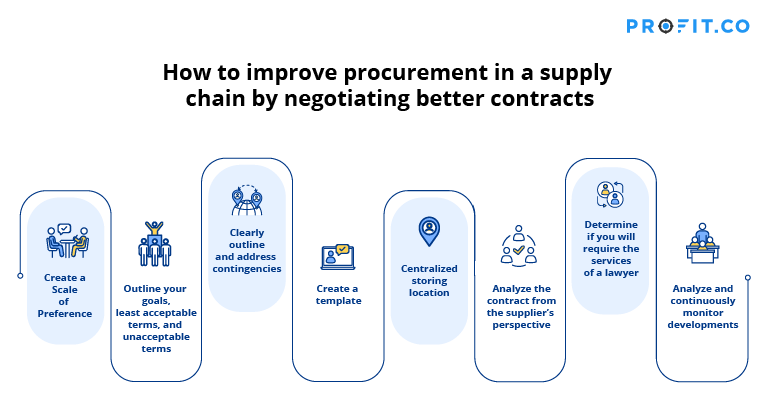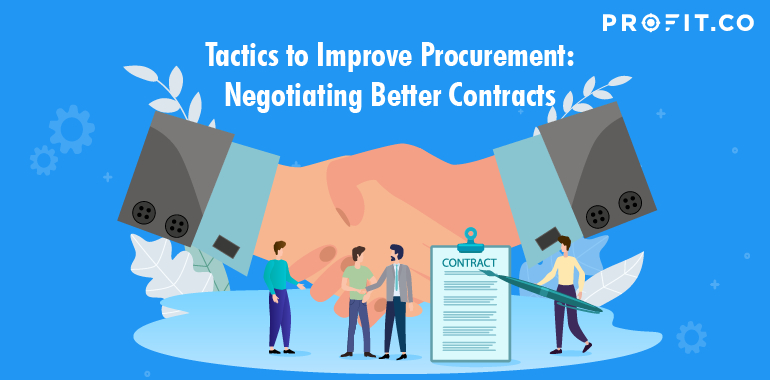Supply Chain Operations
To produce anything, including services, you’ll need raw materials and equipment. The process through which you acquire these needs is called your supply chain. Supply chain operations is more than simply buying raw materials. This chain of operations includes:
- Figuring out what you need, when you need it, how much you currently need or will need in the future
- How long your current stock will last, when you should begin to make a new batch
- How long it will take the needed materials to get to you, how long in advance you should place an order
- Who offers the highest quality of what you need, what is the cheapest possible price and if there any suitable alternatives
Phase 1: Procurement
Supply chain operations can be broken down into six distinct steps. The first phase, which is Procurement, is the actual buying of raw materials from suppliers. Here, we discuss techniques to help you identify and negotiate the best deals with suppliers and also how to manage your suppliers to ensure they always provide you with the best service. With practices such as demand forecasting and vendor management systems, you can optimize the procurement process for the benefit of your entire business.
Procurement in business conclusively involves making buying decisions on the instances of scarcity to ensure the purchaser receives goods, services or work at the most reasonably fair offer when factors such as quality, quantity, time and location are compared.
So, how can the procurement process be improved? One technique to improve procurement is negotiating better contracts.
Place a higher priority on discovering what a win looks like for the other person.
Contract Negotiations Strategies To Enhance The Procurement Process
After successfully negotiating a deal, signing the contract is the next step. A contract is a document that outlines all rules and regulations that all involved parties are to adhere by. This process seals the deal, makes a partnership legally binding, and is the final step in the supplier selection process.
However, contracts still have to be negotiated. So, in a way, contracting is an extension of negotiations. When negotiating a contract, remember the key points raised under negotiations: don’t view the supplier as an opponent you have to defeat, view them more as a partner. A mutually beneficial contract ensures that both parties stay committed to each other and aid themselves in their quests to achieve their business goals and objectives, and this can be the foundation of a long-lasting relationship between both parties.

The objectives of a contract are simple. You should aim to:
- Outline the proper nature, definition, and type of goods and or services to be exchanged.
- Clearly state costs and prices.
- Clearly explain all terms and conditions.
- Detail relevant or significant dates, such as delivery dates, date of commencement and termination of the contract, etc.
- Address potential risks and liabilities and how they should be handled. For example, what happens if a third party delivery company loses the product in transit.
- And lastly, outline the expectations of both parties currently and in the future.
How to negotiate the optimal contract
To help you successfully negotiate a beneficial contract, you need to follow the steps listed earlier under negotiation, and a few more that we will explain subsequently. We’ve listed a few proven practices to help you make the best of your deal:
1. Create a Scale of Preference

A scale of preference is simply a list of wants or needs arranged in an order of preference or importance. Creating this list will enable you to focus on the important items to you, also, if there is ever a need for a trade-off and you need to give something up, you can look to the bottom of the list for the things least important to you. It’s unlikely you will be able to negotiate all areas of the contract at once, so you probably won’t get everything in your scale of preference, but you will at least be able to focus and agree on the most important parts first.
Your scale of preference is subject to change as there will always be a need to add or remove things depending on the nature of the contract in question, so be sure to always review it before negotiating a new contract. For example, try not to confuse your wants with your needs, ask yourself if that thing ranked high in your scale of preference is even necessary, or is it just something you’d like to have. Doing this will help you narrow down and focus on the real issues.
2. Outline your goals, least acceptable terms, and unacceptable terms

Every person or company has a reservation price. In economics, this is the highest price they are willing to pay for something, a price they will not exceed. Determine and outline your reservation price or reservation terms. What is unacceptable? What do you negotiate for? At what point do you stop negotiating? Consider all of this and determine them beforehand so you can use them to negotiate the optimal deal.
3. Clearly outline and address any and all risks and liabilities, time-constraints and benchmarks, confidentiality clauses, and non-competes

As stated in the contract objectives, all of these things and more have to be properly detailed and addressed in the contract. For time constraints, it’s important to have a performance measurement standard that details what you expect from the supplier, if the supplier fails to meet these set expectations, you can agree on an enforceable penalty that will have to be clearly outlined in the contract. For risks and liabilities, you have to decide beforehand who bears certain risks for things that may be beyond the control of both parties.
Lastly, you also have to decide if clauses like non-competes and confidentiality agreements are necessary and you can determine if they are by analyzing your business and its goals and also those of the suppliers. For example, if there is a secret formula or patent information you’d like to keep private then a confidentiality agreement could be necessary.
4. Create a template

Once you’ve done everything leading up to this point, it would be wise to create a template, so you don’t have to begin from scratch every single time you need to enter a contract. This way, drafting a new contract will take significantly less effort and time, allowing you to focus on more important things.
Each department within the business should have a standard language that is easily accessible and adaptable to the terms of the agreement. It would also be ideal to have digitally stored contracts with easily editable headlines. Also, the adoption of electronic signatures will reduce pen and paper costs for your organization, as well as ensure an added layer of security with digital encryption.
5. Centralized storing location

All important and relevant documents should be stored in a central location, preferably digitally. This will make finding, reviewing, and storing information significantly easier than it would be if they were all stored in separate locations.
6. Analyze the contract from the supplier’s perspective

Doing this can give you valuable insight into what’s important to the supplier and what they might be hoping to achieve via the contract, the risks and liabilities they might be willing to bear, what’s important to them and what isn’t. This extra information could be very useful to you. Knowing your partner (supplier) is a very important part of any business endeavor.
7. Determine if you will require the services of a lawyer

Some contracts are more technical and complicated than others, some contracts are simply worth too much to sign without legal counsel present. If you have any doubts about the contract, don’t understand any clauses or you would just feel better having a lawyer present, then invite one.
8. Analyze and continuously monitor developments

Everything you do has to be closely monitored and evaluated, and contract negotiating is no different. The performance of your company should be closely monitored to protect yourself from breaches and potential losses that would follow. You would also need to evaluate the performance of the supplier to ensure that they also do not breach the laws of the contract.
How to improve procurement in a supply chain by negotiating better contracts

1. Create a Scale of Preference
It’s unlikely you will be able to negotiate all areas of the contract at once, so you probably won’t get everything in your scale of preference, but you will at least be able to focus and agree on the most important parts first.
2. Outline your goals, least acceptable terms, and unacceptable terms
Determine and outline your reservation price or reservation terms beforehand so you can use them to negotiate the optimal deal.
3. Clearly outline and address contingencies
Enumerate all risks and liabilities, time constraints and benchmarks, confidentiality clauses, and non-competes
4. Create a template
Create a template, have digitally stored contracts, electronic signatures with digital encryption.
5. Centralized storing location
All important and relevant documents should be stored in a central location, preferably digitally.
6. Analyze the contract from the supplier’s perspective
This can give you valuable insight into what’s important to the supplier and what they might be hoping to achieve via the contract
7. Determine if you will require the services of a lawyer
If you have any doubts about the contract or don’t understand any clauses have a lawyer.
8. Analyze and continuously monitor developments
Evaluate the performance of the supplier and your company to ensure that there is no breach of the laws of the contract.
Final Thoughts
Improving supply chain operations should be at the top of every business’s priority list. This process is vitally important to the health of a business, regardless of the good or service that the business is providing. Procurement, the first step in the operation process, can be improved in a variety of ways.
Negotiating better contracts can create a domino effect in the procurement process, and improve a business’s entire operations experience.
Want more information on supply chain operations, and all things business? Don’t forget to visit the Profit.co blog, where our business experts break down the important topics that you need to master in order to get the best business outcomes.
Ready to optimize your business even more? Read all about OKRs and why industry-leading companies choose to use them. Check out how Profit.co helps you get the most out of your objectives and key results and book a free demo with us today!

